Effect of Surface Roughness on Pitting Corrosion of AZ31 Mg Alloy
Abstract
1. Introduction
2. Materials and Methods
2.1. Materials
2.2. Salt Fog Chamber Exposure
2.3. Material Characterization
3. Results
3.1. Surface Roughness
3.2. Mass and Dimensional Changes during Salt Fog Exposure
4. Discussion
5. Conclusions
Author Contributions
Funding
Acknowledgments
Conflicts of Interest
References
- Kainer, K.U. Magnesium—Alloys and Technology; Wiley: Hoboken, NJ, USA, 2003. [Google Scholar]
- International Air Transport Association. Guidance Material and Best Practices for Fuel and Environmental Management, 1st ed.; International Air Transport Association (IATA): Montreal, QC, Canada, 2004. [Google Scholar]
- Esmaily, M.; Svensson, J.E.; Fajardo, S.; Birbilis, N.; Frankel, G.S.; Virtanen, S.; Arrabal, R.; Thomas, S.; Johansson, L.G. Fundamentals and advances in magnesium alloy corrosion. Prog. Mater Sci. 2017, 89, 92–95. [Google Scholar] [CrossRef]
- Mordike, B.L.; Elbert, T. Magnesium Properties—Applications—Potential. Mater. Sci. Eng. A 2001, 302, 37–45. [Google Scholar] [CrossRef]
- Avedesian, M.M.; Baker, H. ASM Specialty Handbook: Magnesium and Magnesium Alloys; ASM International: Materials Park, OH, USA, 1999. [Google Scholar]
- Azzeddine, H.; Hanna, A.; Dakhouche, A.; Rabahi, L.; Scharnagle, N.; Dopita, M.; Brisset, F.; Helbet, A.; Baudin, T. Impact of rare-earth elements on the corrosion performance of binary magnesium alloys. J. Alloys Compd. 2020, 829, 1–14. [Google Scholar] [CrossRef]
- Jönsson, M.; Persson, D.; Thierry, D. Corrosion product formation during NaCl induced atmospheric corrosion of magnesium alloy AZ91D. Corros. Sci. 2007, 49, 1540–1558. [Google Scholar] [CrossRef]
- Kirkland, N.T.; Lespagnol, J.; Birbilis, N.; Staiger, M.P. A survey of bio-corrosion rates of magnesium alloys. Corros. Sci. 2010, 52, 287–291. [Google Scholar] [CrossRef]
- Hasniyati, M.R.; Zuhailawati, H.; Sivakumar, R.; Dhindaw, B.K. Optimization of multiple responses using overlaid contour plot and steepest methods analysis on hydroxyapatite coated magnesium via cold spray deposition. Surf. Coat. Technol. 2015, 280, 250–255. [Google Scholar] [CrossRef]
- Zhang, L.; Yang, S.; Lv, X.; Jie, X. Wear and corrosion resistance of cold-sprayed Cu-Based composite coatings on magnesium substrate. J. Therm. Spray Technol. 2019, 28, 1212–1224. [Google Scholar] [CrossRef]
- Wei, Y.; Luo, X.; Ge, Y.; Huang, G.; Li, C. Deposition of fully dense Al-based coatings via in-situ micro-forging assisted cold spray for excellent corrosion protection of AZ31B magnesium alloy. J. Alloys Compd. 2019, 806, 1116–1126. [Google Scholar] [CrossRef]
- Siddique, S.; Li, C.; Bernussi, A.A.; Hussain, S.W.; Yasir, M. Enhanced electrochemical and tribological properties of AZ91D magnesium alloy via cold spraying of aluminum alloy. J. Therm. Spray Technol. 2019, 28, 1739–1748. [Google Scholar] [CrossRef]
- Xie, Y.; Planche, M.; Raoelison, R.; Hervé, P.; Sou, X.; He, P.; Liao, H. Investigation on the influence of particle preheating temperature on bonding of cold-sprayed nickel coatings. Surf. Coat. Technol. 2017, 318, 99–105. [Google Scholar] [CrossRef]
- Raoelison, R.N.; Xie, Y.; Sapanathan, T.; Planche, M.P.; Kromer, R.; Costil, S.; Langlade, C. Cold gas dynamic spray technology: A comprehensive review of processing conditions for various technological developments till to date. Addit. Manuf. 2018, 19, 134–159. [Google Scholar] [CrossRef]
- Standard Practice for Operating Salt Spray (Fog) Apparatus, ASTM: B117-11. Available online: http://www.astm.org/cgi-bin/resolver.cgi?B117-11 (accessed on 12 December 2019).
- Esmaily, M.; Ström, M.; Svensson, J.E.; Halvarsson, M.; Johansson, L.G. Corrosion behavior of alloy AM50 in semisolid cast and high-pressure die cast states in cyclic conditions. Corrosion 2015, 71, 737–748. [Google Scholar] [CrossRef]
- Cabrera, N.; Mott, N.F. Theory of the oxidation of metals. Rep. Progr. Phys. 1948, 12, 163–184. [Google Scholar] [CrossRef]
- Agrawal, R.; Baboukani, A.R.; Wang, C. Expanding the potential window of aqueous electrochemical capacitors with binder-free electrostatically sprayed manganese oxide composite cathode films. Mater. Res. Express 2019, 6, 8. [Google Scholar] [CrossRef]
- Agrawal, R.; Adelowo, E.; Baboukani, A.R.; Villegas, M.F.; Henriques, A.; Wang, C. Electrostatic spray deposition-bases manganese oxide films-from pseudocapacitive charge storage materials to three-dimensional microelectrode integrands. Nanomaterials 2017, 7, 198. [Google Scholar] [CrossRef] [PubMed]




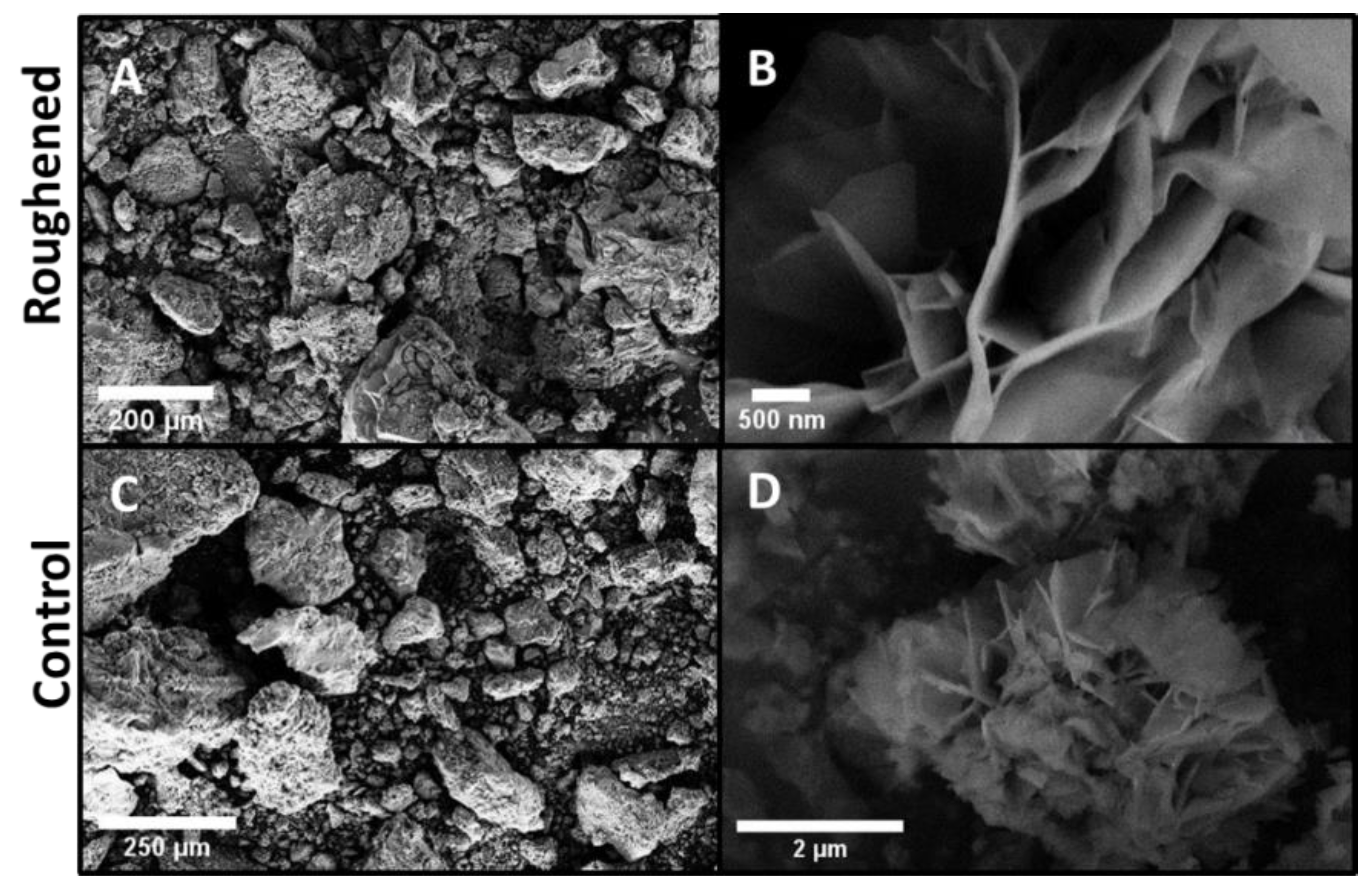
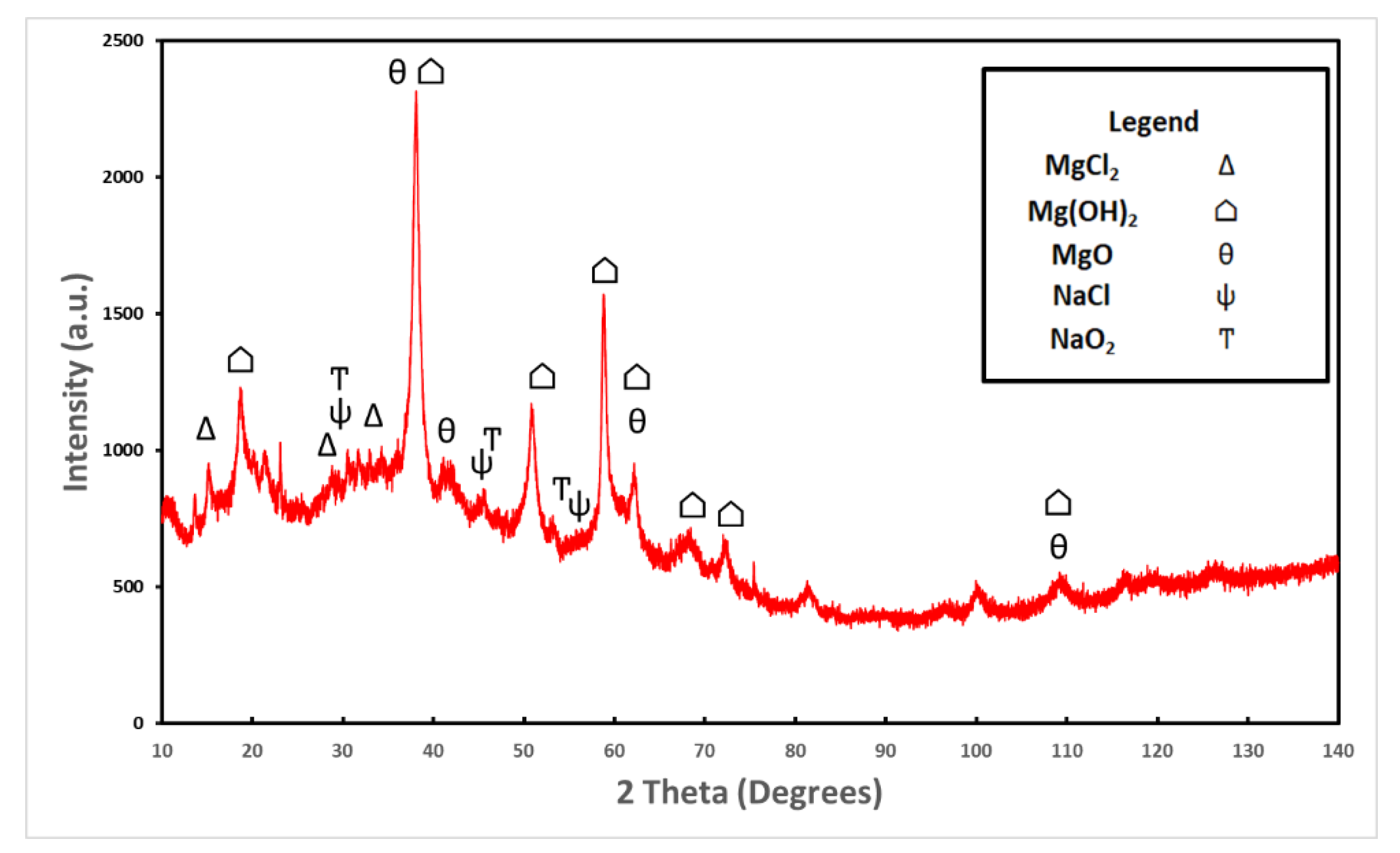
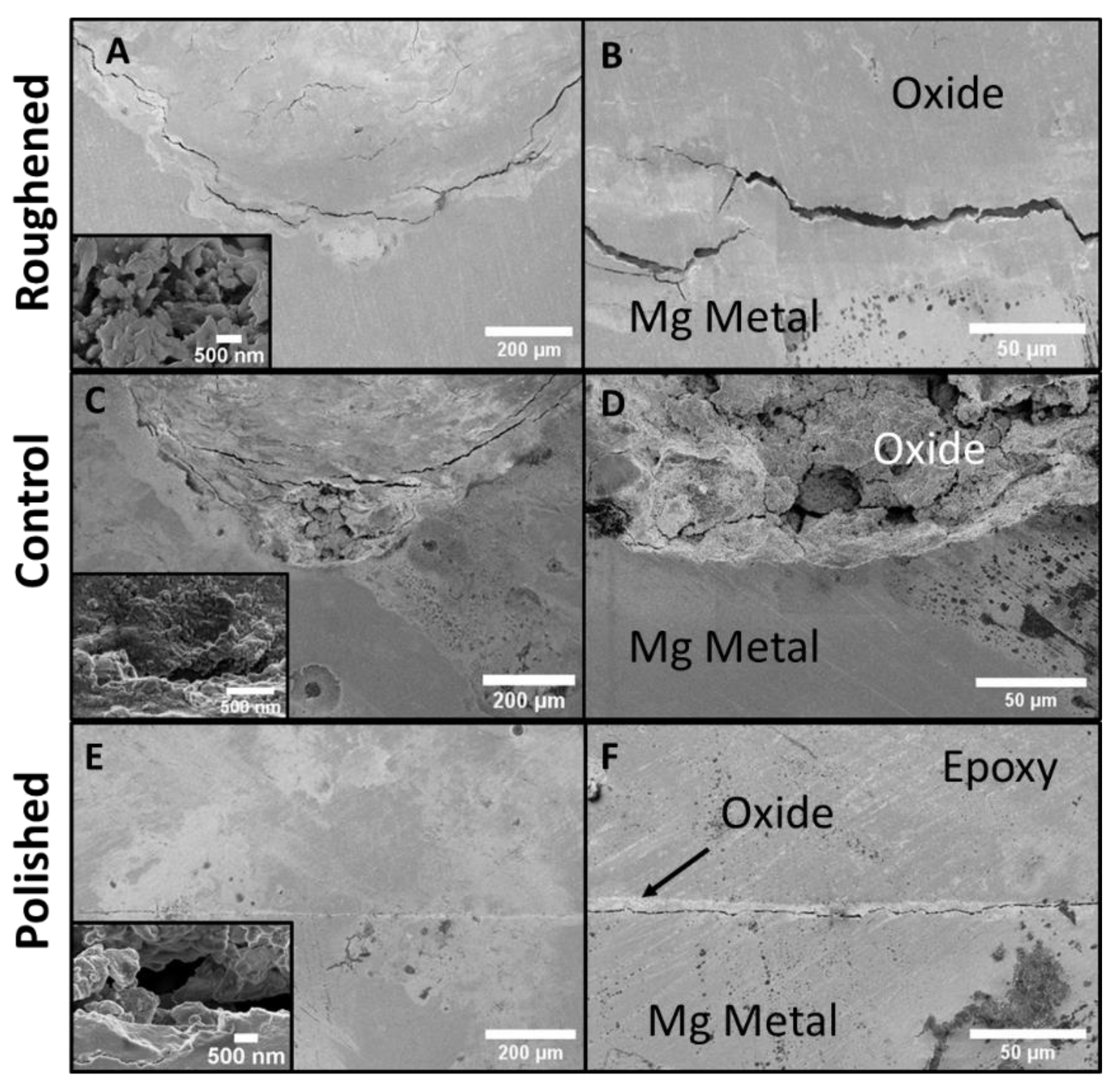
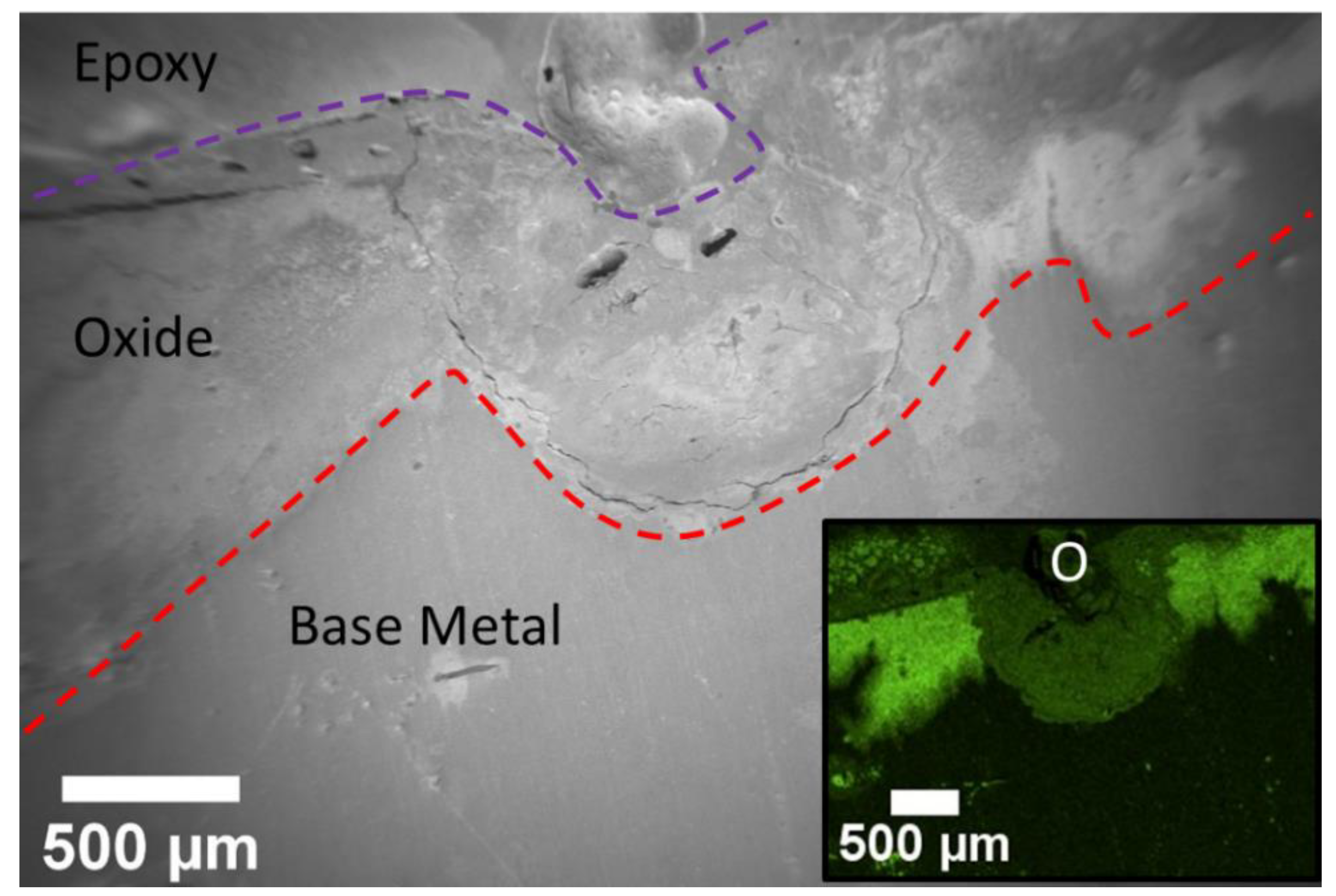
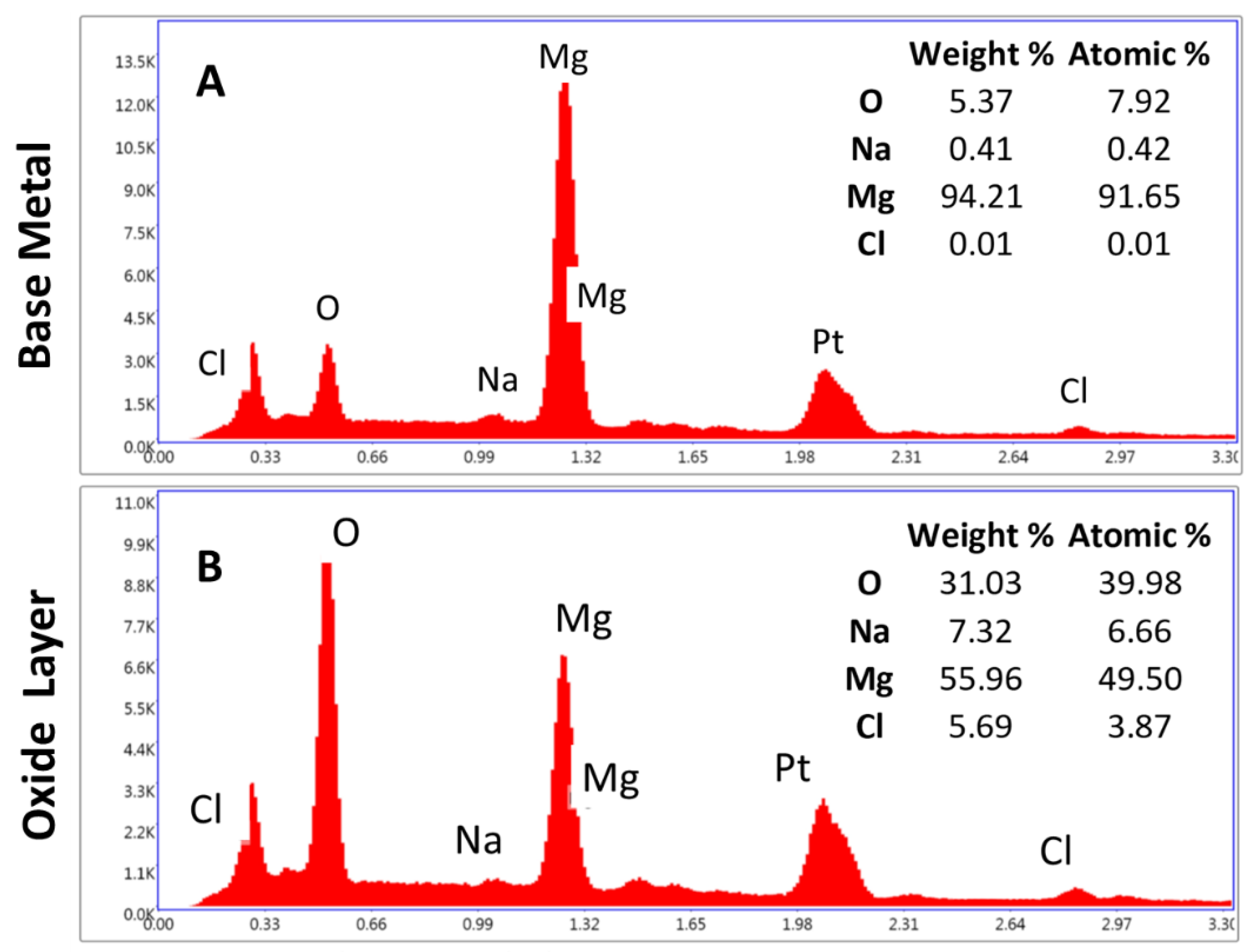
| Polish | ||||||||||
|---|---|---|---|---|---|---|---|---|---|---|
| Time (h) | Length (mm) | Width (mm) | Thickness (mm) | Mass (g) | ||||||
| 0 | 46.00 | 22.20 | 8.69 | 17.10 | ||||||
| 96 | 46.99 | 21.01 | 8.99 | 17.10 | ||||||
| 168 | 47.42 | ± | 0.00 | 21.98 | ± | 0.00 | 9.28 | ± | 0.00 | 17.10 |
| 264 | 46.99 | ± | 0.01 | 21.97 | ± | 0.01 | 9.14 | ± | 0.00 | 17.13 |
| 336 | 46.99 | ± | 0.01 | 22.10 | ± | 0.00 | 9.14 | ± | 0.00 | 17.11 |
| 432 | 46.99 | ± | 0.01 | 21.67 | ± | 0.01 | 8.97 | ± | 0.01 | 17.11 |
| 504 | 46.99 | ± | 0.00 | 21.84 | ± | 0.01 | 8.97 | ± | 0.01 | 17.12 |
| 600 | 46.82 | ± | 0.01 | 21.67 | ± | 0.01 | 8.89 | ± | 0.00 | 17.11 |
| 672 | 46.99 | ± | 0.00 | 21.67 | ± | 0.01 | 8.89 | ± | 0.00 | 17.13 |
| Control | ||||||||||
|---|---|---|---|---|---|---|---|---|---|---|
| Time (h) | Length (mm) | Width (mm) | Thickness (mm) | Mass (g) | ||||||
| 0 | 47.60 | 22.20 | 9.50 | 18.11 | ||||||
| 96 | 47.98 | 22.50 | 9.50 | 18.19 | ||||||
| 168 | 47.99 | ± | 0.00 | 22.75 | ± | 0.00 | 9.73 | ± | 0.01 | 18.07 |
| 264 | 47.75 | ± | 0.00 | 22.48 | ± | 0.01 | 9.40 | ± | 0.00 | 17.90 |
| 336 | 47.58 | ± | 0.01 | 22.52 | ± | 0.01 | 9.23 | ± | 0.01 | 17.89 |
| 432 | 47.58 | ± | 0.01 | 22.52 | ± | 0.01 | 9.23 | ± | 0.01 | 17.86 |
| 504 | 47.75 | ± | 0.00 | 22.35 | ± | 0.00 | 9.06 | ± | 0.01 | 17.89 |
| 600 | 47.41 | ± | 0.01 | 22.10 | ± | 0.00 | 8.89 | ± | 0.00 | 17.88 |
| 672 | 47.58 | ± | 0.01 | 22.35 | ± | 0.00 | 9.06 | ± | 0.01 | 17.87 |
| Roughened | ||||||||||
|---|---|---|---|---|---|---|---|---|---|---|
| Time (h) | Length (mm) | Width (mm) | Thickness (mm) | Mass (g) | ||||||
| 0 | 47.60 | 22.20 | 9.50 | 18.03 | ||||||
| 96 | 48.49 | 22.00 | 8.99 | 18.19 | ||||||
| 168 | 48.25 | ± | 0.00 | 22.87 | ± | 0.00 | 9.92 | ± | 0.00 | 18.23 |
| 264 | 48.01 | ± | 0.00 | 22.61 | ± | 0.00 | 9.14 | ± | 0.00 | 17.72 |
| 336 | 48.09 | ± | 0.01 | 22.61 | ± | 0.00 | 9.40 | ± | 0.00 | 17.85 |
| 432 | 47.92 | ± | 0.01 | 22.52 | ± | 0.01 | 9.31 | ± | 0.01 | 17.75 |
| 504 | 47.67 | ± | 0.01 | 22.35 | ± | 0.00 | 9.31 | ± | 0.01 | 17.75 |
| 600 | 47.33 | ± | 0.01 | 22.10 | ± | 0.00 | 9.06 | ± | 0.01 | 17.76 |
| 672 | 47.50 | ± | 0.00 | 22.35 | ± | 0.00 | 9.23 | ± | 0.01 | 17.77 |
© 2020 by the authors. Licensee MDPI, Basel, Switzerland. This article is an open access article distributed under the terms and conditions of the Creative Commons Attribution (CC BY) license (http://creativecommons.org/licenses/by/4.0/).
Share and Cite
Mitchell, J.; Crow, N.; Nieto, A. Effect of Surface Roughness on Pitting Corrosion of AZ31 Mg Alloy. Metals 2020, 10, 651. https://doi.org/10.3390/met10050651
Mitchell J, Crow N, Nieto A. Effect of Surface Roughness on Pitting Corrosion of AZ31 Mg Alloy. Metals. 2020; 10(5):651. https://doi.org/10.3390/met10050651
Chicago/Turabian StyleMitchell, Jeffrey, Natalie Crow, and Andy Nieto. 2020. "Effect of Surface Roughness on Pitting Corrosion of AZ31 Mg Alloy" Metals 10, no. 5: 651. https://doi.org/10.3390/met10050651
APA StyleMitchell, J., Crow, N., & Nieto, A. (2020). Effect of Surface Roughness on Pitting Corrosion of AZ31 Mg Alloy. Metals, 10(5), 651. https://doi.org/10.3390/met10050651




